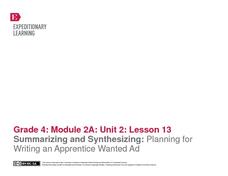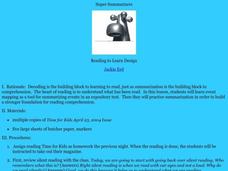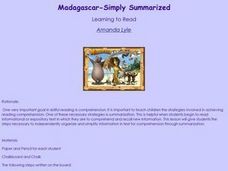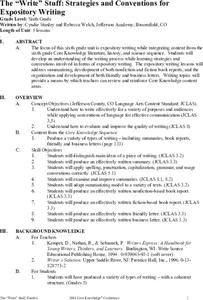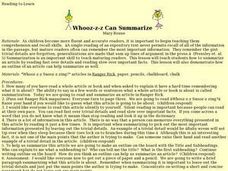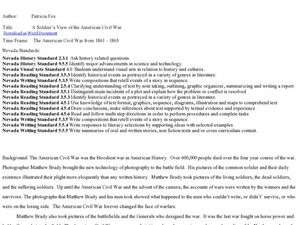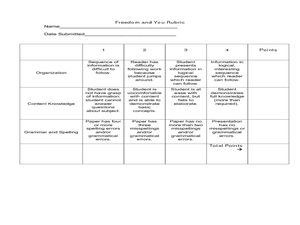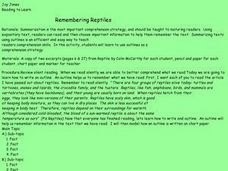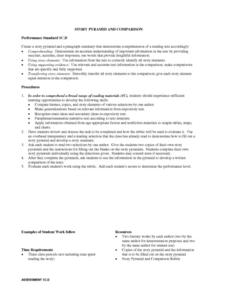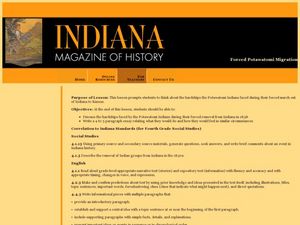Curated OER
Summarization Superstars
How do you read when you know you're going to be summarizing a text? Summarize a nonfiction text with your upper elementary schoolers. Your pupils independently read a nonfiction article and write a summary paragraph using the six-step...
Curated OER
Narrative vs. Expository Texts
Young scholars use examples of narrative and expository text to analyze and compare the two styles. Students read articles on life in Lesotho and Madagascar and use graphic organizers and discussion to compare them. Young scholars write...
EngageNY
Summarizing and Synthesizing: Planning for Writing an Apprentice Wanted Ad
In instructional activity 13 of this unit on colonial trade, young researchers learn about apprentices as they prepare to write help-wanted ads for the specific trade they have been researching. To begin, the class listens closely as the...
Curated OER
Only the Facts
Practice the strategy of summarizing to gain meaning and knowledge from an informational text. Young readers highlight supporting details and main ideas, and then they use this to summarize two articles: "The Great Quake" and "What...
Curated OER
Super Summarizers
Students examine the process of summarization by creating an event map. They discuss the process of summarizing text, then silently read an article from "Time For Kids" magazine. Students observe the teacher create a map for the...
Curated OER
Slim Down to the Good Stuff by Summarizing
Students summarize a piece of literature using the technique "mapping" in this lesson. The technique involves 6 main steps: delete unimportant information, delete repeated information, substitute easy terms, add a series of event with...
Curated OER
Madagascar-Simply Summarized
Students summarize a selected piece of text nonfiction text. After reviewing the correct way to read silently, students read a nonfiction article. They write a summary paragraph using the four step process outlined by the instructor. ...
Curated OER
Just Get to the Good Part
Students summarize nonfiction text. After reviewing the steps for summarization, students independently read a nonfiction article. They write a summary paragraph using the six-step process outlined by the instructor during guided practice.
Curated OER
To Sum it all Up...
Students observe and demonstrate the process of summarizing text. They read and discuss the steps to summarize text, then in small groups read and summarize an article about frogs from "National Geographic" online. Independently they...
Curated OER
The "Write" Stuff: Strategies and Conventions for Expository Writing
Students develop their expository writing skills while integrating various other subjects. In this writing skills lesson, students complete 4 multiple activity lessons to improve their expository writing skills.
Curated OER
Learning From World War II and Connecting It to the Present
Compare and contrast World War II to the modern Iraq war with this instructional activity. After watching a film, learners use supporting evidence to support their point of view of the conflicts. Using the internet, they create a...
Curated OER
Let's Sum It Up
Students summarize a selected piece of nonfiction text as a group. After reviewing the instructors preferred method for summarizing information by identifying the main idea and supporting details, groups write a summary paragraph of a...
Curated OER
Whooz-z-z Can Summarize
Students summarize an article by reading fast for details and reading slow for important facts. They practice outlining an article. They identify parts of an article such as the title and subheading. They write a short and concise...
Curated OER
A Soldier's View of the American Civil War
Study and research the American Civil War in this explanatory writing lesson. Middle schoolers complete six activities to learn about the American Civil War and soldiers' views of the war. The lesson includes several options to complete...
Curated OER
Synthesis of Information
Locating and synthesizing information is an essential part of the research process but can be overwhelming for many young writers. Eliminate some of the stress and confusion, this resource suggests, by separating these steps. To focus...
Curated OER
Freedom and You
Students research the American Revolution. In this Revolutionary War lesson, students research facts about the American Revolution, write an expository essay, and peer edit for good content. The paper is suggested to be written after...
Curated OER
Remembering Reptiles
Students will learn to use outlines as a comprehension strategy. Summarization is the most important comprehension strategy, and should be taught to maturing readers. During this instructional activity learners use the story of a reptile...
Curated OER
Do We Have to Do This?
High schoolers conduct Internet research, and read articles about education to determine why particular educational practices are used, and why they are important in terms of No Child Left Behind. Students create PowerPoint presentations...
Curated OER
Story Pyramid And Comparison
Pupils investigate the details of a chosen story of literature. They use a pyramid graphic organizer to record information. The information is used to write a summary of the story. Students use a rubric while writing the summary to check...
Curated OER
No Plagiarism, Please!
Third graders listen to a lecture on how to take notes and discuss the skills of paraphrasing and correctly citing resources. They prepare note cards according to the format presented in class.
Curated OER
Information Shuffle
Gather some information, print it onto sentence strips, and then have your class physically shuffle the cards to better understand the importance of organizational patterns in writing. Middle school learners examine information for a...
Curated OER
Rights and the Wyandotte Constitution
Every state uses a set of rights to establish laws and regulations. Explore the Wyandotte Constitution as it was written in 1859 and compare it with how rights in Kansas have changed, especially those that pertain to gender and race. A...
Curated OER
Forced Potawatomi Migration
Fourth graders write about the forced Potawatomi migration. In this primary source lesson plan students are read journal entries from an emigrating party of Potawatomi Indians. Students reflect on the items the Indians might have taken...
Curated OER
Stone Fox Plot Frame
Fifth graders recall the major plot points of a chapter book. After reading the chapter book "Stone Fox," they students describe the plot framework through use of a worksheet. Students are then divided into group to act out selected...


